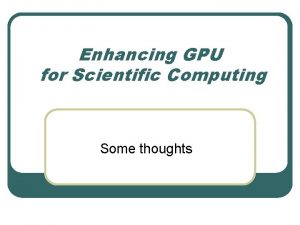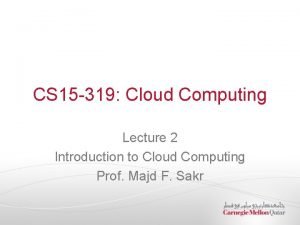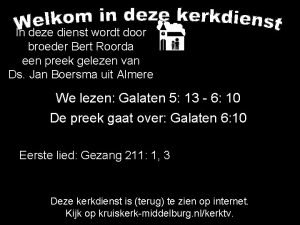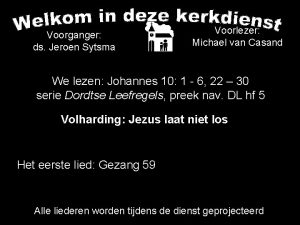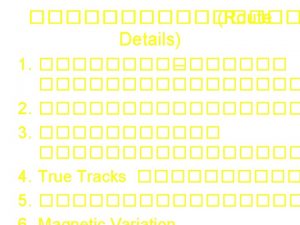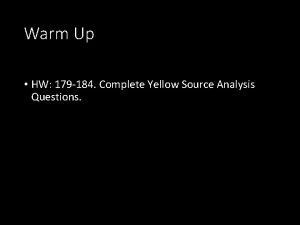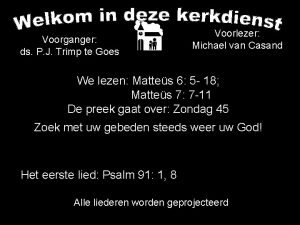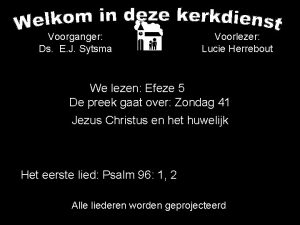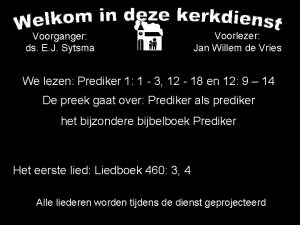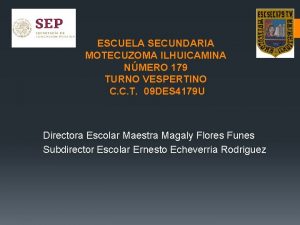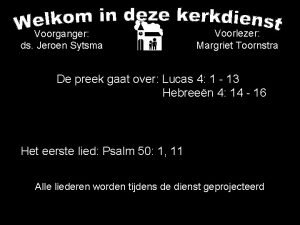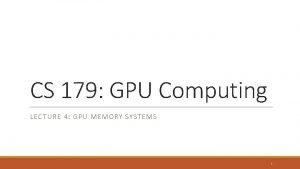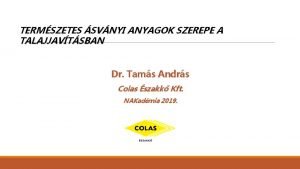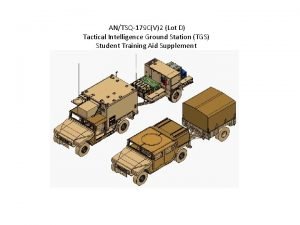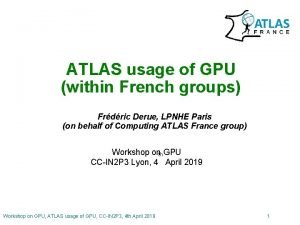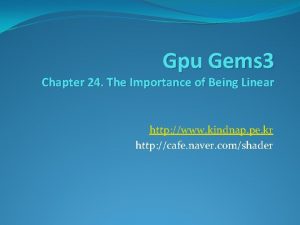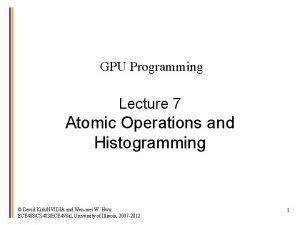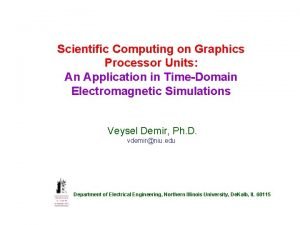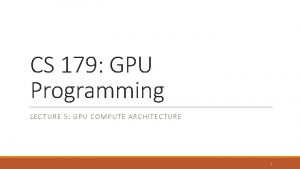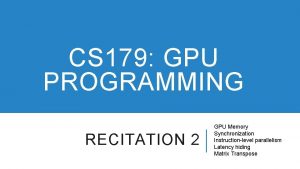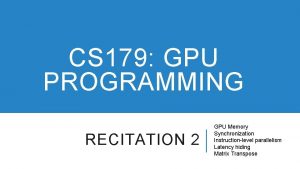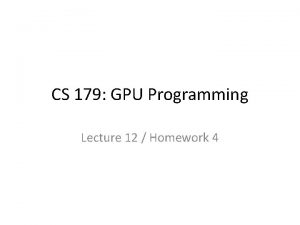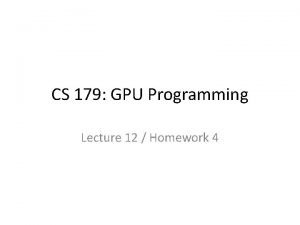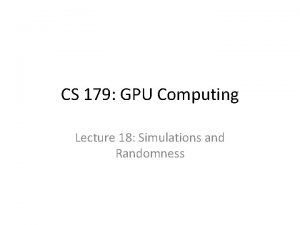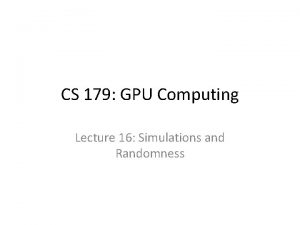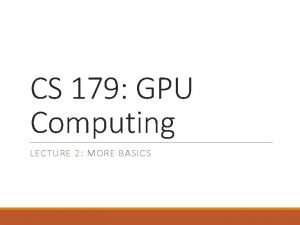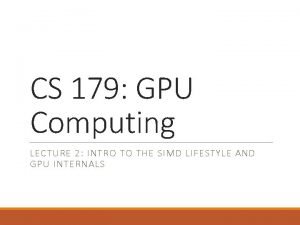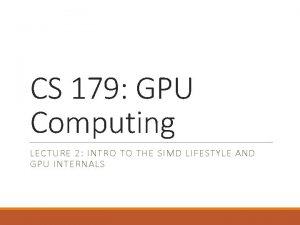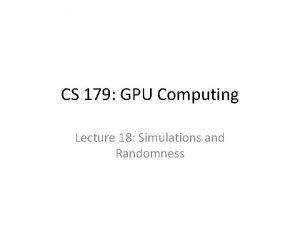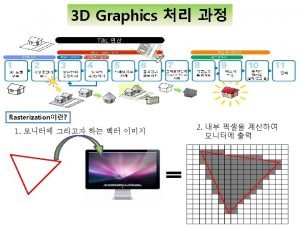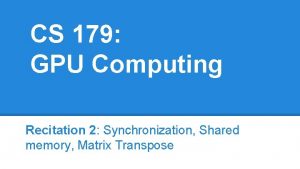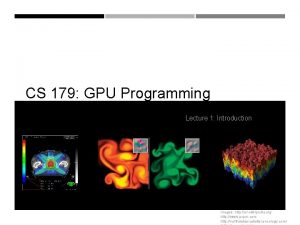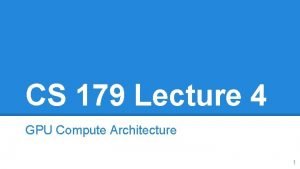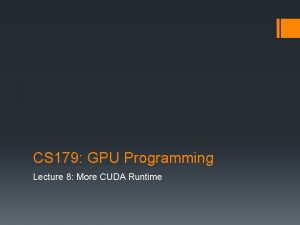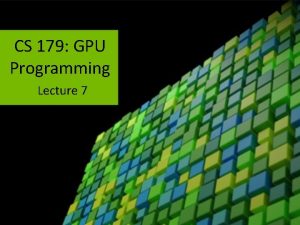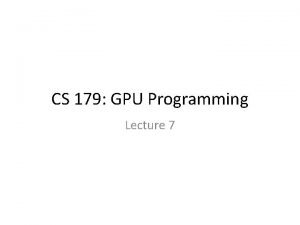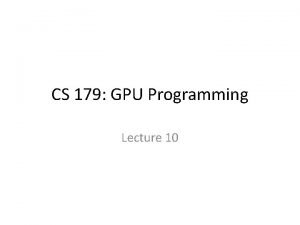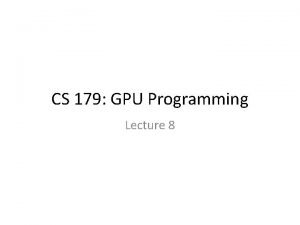CS 179 GPU Computing Lecture 3 Homework 1







![Simple Moving Average • x[n]: input (the raw signal) • y[n]: simple moving average Simple Moving Average • x[n]: input (the raw signal) • y[n]: simple moving average](https://slidetodoc.com/presentation_image/4219162e1d2fa5d90db1f04ae1240e72/image-8.jpg)





![Comparison • Calculation for y[n] depends on calculation for y[n-1] ! Comparison • Calculation for y[n] depends on calculation for y[n-1] !](https://slidetodoc.com/presentation_image/4219162e1d2fa5d90db1f04ae1240e72/image-14.jpg)
![Comparison • SMA pseudocode: for i = 0 through N-1 y[n] <- x[n] +. Comparison • SMA pseudocode: for i = 0 through N-1 y[n] <- x[n] +.](https://slidetodoc.com/presentation_image/4219162e1d2fa5d90db1f04ae1240e72/image-15.jpg)
![Comparison • SMA pseudocode: for i = 0 through N-1 y[n] <- x[n] +. Comparison • SMA pseudocode: for i = 0 through N-1 y[n] <- x[n] +.](https://slidetodoc.com/presentation_image/4219162e1d2fa5d90db1f04ae1240e72/image-16.jpg)




















![Debugging tips • Use small convolution test case – E. g. 5 -element x[n], Debugging tips • Use small convolution test case – E. g. 5 -element x[n],](https://slidetodoc.com/presentation_image/4219162e1d2fa5d90db1f04ae1240e72/image-37.jpg)


- Slides: 39

CS 179: GPU Computing Lecture 3 / Homework 1

Recap • Adding two arrays… a close look – Memory: • Separate memory space, cuda. Malloc(), cuda. Memcpy(), … – Processing: • Groups of threads (grid, blocks, warps) • Optimal parameter choice (#blocks, #threads/block) – Kernel practices: • Robust handling of workload (beyond 1 thread/index)

Parallelization • What are parallelizable problems?

Parallelization • What are parallelizable problems? • e. g. – Simple shading: for all pixels (i, j): replace previous color with new color according to rules – Adding two arrays: for (int i = 0; i < N; i++) C[i] = A[i] + B[i];

Parallelization • What aren’t parallelizable problems? – Subtle differences!

Moving Averages http: //www. ligo. org

Moving Averages
![Simple Moving Average xn input the raw signal yn simple moving average Simple Moving Average • x[n]: input (the raw signal) • y[n]: simple moving average](https://slidetodoc.com/presentation_image/4219162e1d2fa5d90db1f04ae1240e72/image-8.jpg)
Simple Moving Average • x[n]: input (the raw signal) • y[n]: simple moving average of x[n] • Each point in y[n] is the average of the last K points!

Simple Moving Average •

Exponential Moving Average •


Comparison •

Comparison •
![Comparison Calculation for yn depends on calculation for yn1 Comparison • Calculation for y[n] depends on calculation for y[n-1] !](https://slidetodoc.com/presentation_image/4219162e1d2fa5d90db1f04ae1240e72/image-14.jpg)
Comparison • Calculation for y[n] depends on calculation for y[n-1] !
![Comparison SMA pseudocode for i 0 through N1 yn xn Comparison • SMA pseudocode: for i = 0 through N-1 y[n] <- x[n] +.](https://slidetodoc.com/presentation_image/4219162e1d2fa5d90db1f04ae1240e72/image-15.jpg)
Comparison • SMA pseudocode: for i = 0 through N-1 y[n] <- x[n] +. . . + x[n-(K-1)] • EMA pseudocode: for i = 0 through N-1 y[n] <- c*x[n] + (1 -c)*y[n-1] – Loop iteration i depends on iteration i-1 ! – Far less parallelizable!
![Comparison SMA pseudocode for i 0 through N1 yn xn Comparison • SMA pseudocode: for i = 0 through N-1 y[n] <- x[n] +.](https://slidetodoc.com/presentation_image/4219162e1d2fa5d90db1f04ae1240e72/image-16.jpg)
Comparison • SMA pseudocode: for i = 0 through N-1 y[n] <- x[n] +. . . + x[n-(K-1)] – Better GPU-acceleration • EMA pseudocode: for i = 0 through N-1 y[n] <- c*x[n] + (1 -c)*y[n-1] – Loop iteration i depends on iteration i-1 ! – Far less parallelizable! – Worse GPU-acceleration

Morals • Not all problems are parallelizable! – Even similar-looking problems • Recall: Parallel algorithms have potential in GPU computing

Small-kernel convolution Homework 1 (coding portion)

Signals

Systems • Given input signal(s), produce output signal(s)

Discretization • Discrete samplings • of continuous signals – Continuous audio signal -> WAV file – Voltage -> Voltage every T milliseconds • (Will focus on discrete-time signals here)

Linear systems •

Linear systems • Consider a tiny piece of the signal

Linear systems •

Linear systems •

Time-invariance •

Time-invariance •

Time-invariance and linearity •

Time-invariance and linearity •

Morals •

Convolution example •

Computability •

This assignment • Accelerate this computation! – Fill in TODOs on assignment 1 • Kernel implementation • Memory operations – We give the skeleton: • • CPU implementation (a good reference!) Output error checks h[n] (default is Gaussian impulse response) …

The code • Framework code has two modes: – Normal mode (AUDIO_ON zero) • Generates random x[n] • Can run performance measurements on different sizes of x[n] • Can run multiple repeated trials (adjust channels parmeter) – Audio mode (AUDIO_ON nonzero) • Reads input WAV file as x[n] • Outputs y[n] to WAV • Gaussian is an imperfect low-pass filter – high frequencies attenuated!

Demonstration

Debugging tips • Printf – Beware – you have many threads! – Set small number of threads to print • Store intermediate results in global memory – Can copy back to host for inspection • Check error returns! – gpu. Errchk macro included – wrap around function calls
![Debugging tips Use small convolution test case E g 5 element xn Debugging tips • Use small convolution test case – E. g. 5 -element x[n],](https://slidetodoc.com/presentation_image/4219162e1d2fa5d90db1f04ae1240e72/image-37.jpg)
Debugging tips • Use small convolution test case – E. g. 5 -element x[n], 3 -element h[n]

Compatibility • Our machines: – haru. caltech. edu – (We’ll try to get more up as the assignment progresses) • CMS machines: – Only normal mode works • (Fine for this assignment) • Your own system: – Dependencies: libsndfile (audio mode)

Administrivia • Due date: – Wednesday, 3 PM (correction) • Office hours (ANB 104): – Kevin/Andrew: Monday, 9 -11 PM – Eric: Tuesday, 7 -9 PM
 Best gpu for scientific computing
Best gpu for scientific computing Gpu computing matlab
Gpu computing matlab 01:640:244 lecture notes - lecture 15: plat, idah, farad
01:640:244 lecture notes - lecture 15: plat, idah, farad Homework oh homework i hate you you stink
Homework oh homework i hate you you stink Grant always turns in his homework
Grant always turns in his homework Jack prelutsky homework oh homework
Jack prelutsky homework oh homework Homework oh homework
Homework oh homework Homework oh homework i hate you you stink
Homework oh homework i hate you you stink Homework oh homework i hate you you stink
Homework oh homework i hate you you stink Parallel and distributed computing lecture notes
Parallel and distributed computing lecture notes Cloud computing cmu
Cloud computing cmu Conventional computing and intelligent computing
Conventional computing and intelligent computing Gezang 179
Gezang 179 Jeroen sytsma
Jeroen sytsma Himno 179
Himno 179 Frank roorda
Frank roorda 0-179 altitude
0-179 altitude Hw-179
Hw-179 Gezang 179
Gezang 179 Prosessikaavion piirtäminen
Prosessikaavion piirtäminen Gezang 179
Gezang 179 Din 1125 und din 179
Din 1125 und din 179 49 cfr parts 171-179
49 cfr parts 171-179 Gezang 179
Gezang 179 Gezang 179
Gezang 179 Cara memanfaatkan pancaindera
Cara memanfaatkan pancaindera What does tyrone compare/contrast
What does tyrone compare/contrast Escuela secundaria 179 motecuzoma ilhuicamina
Escuela secundaria 179 motecuzoma ilhuicamina Jhs 179
Jhs 179 Jeroen sytsma
Jeroen sytsma Cs 179
Cs 179 Jhs 179
Jhs 179 Gezang 179
Gezang 179 791-179-455
791-179-455 Mdas antenna
Mdas antenna Gpu in french
Gpu in french Gpu gems 4
Gpu gems 4 Gpu atomic operations
Gpu atomic operations Chrome helper gpu
Chrome helper gpu Cpu vs gpu
Cpu vs gpu
